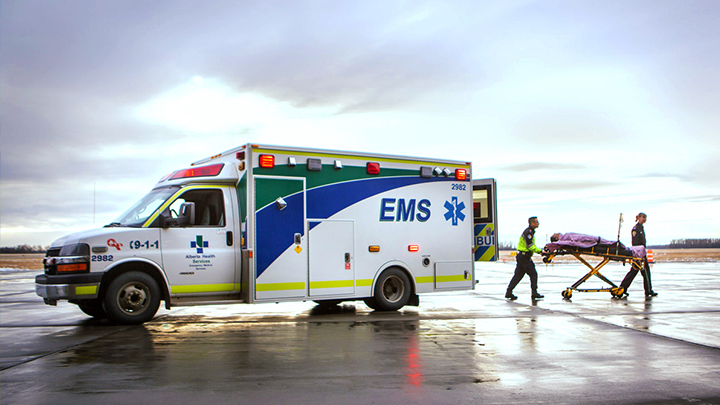
March 16, 2021

As COVID-19 vaccines roll out, EMS remains committed to finding new ways to innovate and deliver safe, appropriate care to all Albertans during the pandemic. Photo supplied.
Story by Erin Lawrence
Keeping cool under pressure is what EMS paramedics do daily, thanks to their training. As the COVID-19 pandemic ramped up a year ago, Emergency Medical Services (EMS) swiftly ramped up their procedures and preparedness.
One of their first steps was to activate the EMS Provincial Coordination Center (PCC).
“Our PCC was activated to allow AHS EMS to have a consistent, coordinated approach to managing our entire response to the pandemic,” says Darren Sandbeck, Chief Paramedic and Senior Provincial Director, EMS.
“The PCC allows us to effectively and consistently communicate with staff on all issues related to COVID-19, including Personal Protective Equipment (PPE) usage, vehicle and equipment cleaning, patient screening, care and treatment.”
Effectively running and leading COVID-19 activities via the PCC has allowed EMS to keep staff safe and ensure patients continue to receive timely and appropriate care during the pandemic.
“As a provincial ambulance service, having the PCC as a single point of contact for our colleagues and stakeholders allows for unified and consistent handling of information across all branches of EMS,” says Mike Plato, Associate Executive Director, EMS Business Standards and Operations Support. “Coordinating these activities centrally is essential for safety, consistency and quality patient care.”
With the launch of the PCC, the need also arose for paramedics to don more PPE than in the past.
“EMS paramedics adapted quickly to the increased use of PPE during the pandemic,” adds David Warhaft, Interim Director, Clinical Operations at EMS.
“They dealt with challenges that come along with needing to don PPE quickly in emergency response and mobile scenarios in the back of a moving vehicle. As a result of our paramedics’ continued diligence and commitment to safety.”
With the immediate need for testing and contact tracing, members of the EMS Mobile Integrated Health (MIH) — also known as Community Paramedics — were the first front-line practitioners in Alberta to do in-home COVID-19 testing.
Community Paramedics, previously equipped and trained to conduct nasopharyngeal swabs as part of their standard practice, immediately added COVID-19 to their testing capabilities. As well, they also stepped up to provide mobile COVID-19 testing to vulnerable populations.
Testing requests, relayed by the local Medical Officer of Health, brought tests to frail, elderly, homeless individuals as well as others with physical or cognitive disabilities who were unable to access community testing sites.
“EMS Mobile Integrated Healthcare was also directly involved in the validation of the new Panbio rapid antigen test,” says Ryan Kozicky, Director, EMS Mobile Integrated Healthcare. “Their validation work was recently published in the Journal of Microbiology and Infectious Diseases, which included MIH in the recognition and acknowledgements.”
In response to the pandemic, EMS also introduced new 911 screening guidelines to help on-scene paramedics prepare appropriately for all medical emergencies. EMS Emergency Communications Officers (ECO’s) began using the Emerging Infectious Disease Surveillance Tool which uses special screening questions to identify potential symptoms of influenza-like illness before first responders arrive on scene.
“As the outbreak evolved, the Pandemic-Epidemic-Outbreak protocol, or Protocol 36, was implemented,” says Marty Scott, Executive Director, EMS Provincial Programs. “ECO’s continue to use the protocol today to identify potential safety issues for staff, and to accumulate data with respect to COVID-19 surveillance,”
As vaccines roll out, EMS remains committed to finding new ways to innovate and deliver safe, appropriate care to all Albertans.